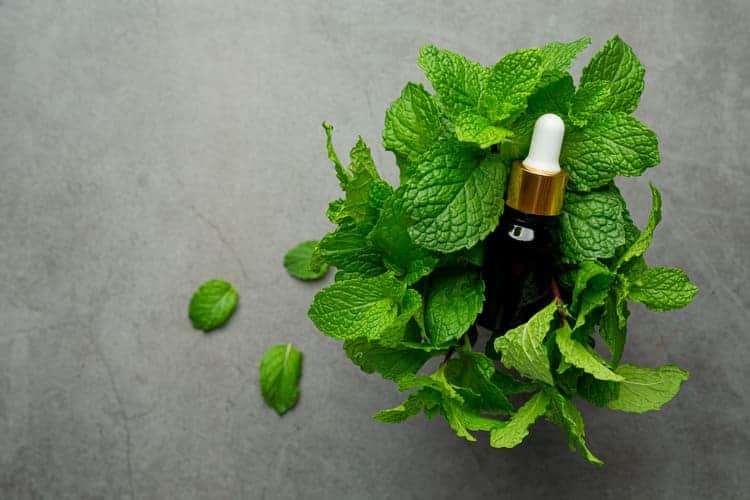
As far as natural remedies for hot flashes go, peppermint oil is one you shouldn’t overlook.
Not only is peppermint essential oil known for being cooling, but it’s also anti-inflammatory.
And those are two things you want in any hot flash remedy.
In this article, we’ll explore how to use peppermint oil for hot flashes:
- The proper dilution to use (and some complimentary oils to pair with peppermint).
- Where to apply peppermint oil.
- Why peppermint helps to relieve hot flashes.
Let’s get to it!
NOTE: This article contains some affiliate links and I earn a commission (at no additional cost to you) if you use them to make a purchase.
HOW TO DILUTE AND USE PEPPERMINT OIL FOR HOT FLASHES
1. Make a cooling roller blend oil
When applied to the skin, peppermint feels cooling and soothing.
So, this can be the best way to use it for hot flashes.
Do keep in mind that peppermint oil – like all essential oils – must be diluted with a carrier oil before applying it to the skin. Any light oil like grapeseed, jojoba or almond can be used as a carrier.
In addition, the suggested maximum dilution ratio for peppermint oil is 5%.
This means that going above 5% is more likely to cause irritation to the skin.
Now, if you’re brand new to using peppermint oil for hot flashes, I suggest starting with a lower dilution.
So, rather than start at 5%, consider starting at 3%. If that doesn’t provide the relief you need, then increase to 4% and eventually 5%.
Remember that essential oils are very potent and you really don’t want to use much more than your body needs. More isn’t better.
The table below shows you how much peppermint oil and carrier oil to use for different dilutions.
| Dilution Ratio | Amount of Essential Oil + Carrier Oil |
|---|---|
| 3% | 27 drops peppermint oil + 1 oz ounce carrier |
| 4% | 36 drops peppermint oil + 1 oz ounce carrier |
| 5% | 45 drops peppermint oil + 1 oz ounce carrier |
Besides using peppermint oil on its own, you can also include the following oils in your blend. They’re all known to support women’s hormones:
- lavender.
- geranium.
- sandalwood.
When you add other oils to the mix make sure to pay attention to the maximum dilution ratio for each oil and adapt your final recipe accordingly.
2. Use a prediluted peppermint oil
If you don’t feel like doing any mixing, then this prediluted peppermint oil is for you.
It’s diluted to 5% and ready to use.
3. Inhale or diffuse mint oil
A quick whiff of peppermint oil can calm your nervous system, even when you feel a hot flash coming on.
You can simply diffuse a few drops of peppermint oil for up to 30 minutes or apply two drops of undiluted peppermint oil to a cotton ball.
Hold the ball close to your nose and inhale.
4. Add to bath water
A relaxing bath helps you relax and helps your nervous system – which plays a role in hot flashes – to calm down.
By adding peppermint oil to your bath, you can further support your body and ease hot flashes.
Just remember that oil and water don’t mix.
So, in order to safely use peppermint oil in a bath – and not burn or irritate your skin – follow these guidelines:
- Mix a few drops – about 5 to start – of mint oil with 1 tablespoon of castile soap. The soap helps the oil
- Add the mixture to your bath water.
- Relax and enjoy your soak.
WHERE TO APPLY PEPPERMINT ESSENTIAL OIL FOR HOT FLASHES
For hot flash relief, apply diluted peppermint oil to the neck, shoulder and chest area as needed.
You could also try applying the oil to the bottom of your feet, although the amount of oil you absorb will be less (since the skin on the soles of the feet is thicker).
That said, the bottom of the feet contains reflexology points that are particularly helpful for calming the nervous system.
So, you could take a few minutes to give yourself a relaxing foot massage and use your essential oil to enhance the relaxation factor.
For more information on using essential oils as a whole, be sure to read this guide on where to apply essential oils.
HOW PEPPERMINT ESSENTIAL OIL HELPS WITH HOT FLASHES

1. Rich in Cooling Menthol
Peppermint has a high concentration of menthol – about 50% depending on the harvest.
This compound has a cooling effect on the body, which helps to curb hot flashes, even while in progress.
NOTE: this cooling property is in effect whether you use peppermint topically or you drink the tea (though the amount of menthol in a tea won’t be as high as the essential oil).
2. Calms The Nervous System
Part of peppermint’s cooling effect is reflected in how it affects the the nervous system, where it has a calming and relaxing action.
This is a major benefit for anyone struggling with hot flashes because research indicates that the nervous system plays a key role in regulating the onset of a hot flash.
Therefore, anything that calms the nervous system can help alleviate the intensity or frequency of hot flashes.
FAQS ABOUT PEPPERMINT OIL AND HOT FLASHES
What essential oil is good for menopause hot flashes?
Some of the best essential oils to relieve hot flashes include:
- Clary sage.
- Geranium.
- Lavender.
- Ylang ylang.
For the full list of oils you can use, read this guide on essential oils for menopause.
What helps hot flashes at night naturally?
Aside from natural remedies like peppermint oil, you the following tips may ease night sweats:
- Mind-body techniques: whether it’s meditating, gentle yoga or a soothing Qi-Gong practice, bringing awareness to your mind-body connection calms the nervous system (which in turn helps with hot flashes).
- Herbs: evening primrose oil, black cohosh and st john’s wort are a few herbs that may alleviate night sweats. Use this guide to learn more about herbs for menopause hot flashes.
What makes hot flashes worse at night?
Several factors can contribute to the worsening of hot flashes at night. For example, one study showed that sleep deprivation and poor sleep quality can exacerbate hot flashes at night.
In addition, the body’s circadian rhythm – which regulates your sleep-wake cycle – can influence the hot flashes.
Furthermore, hormonal imbalance can make it more difficult for your body to properly regulate body temperature.
What essential oils stop night sweats?
A combination of cooling and hormone-balancing oils may help night sweats. This includes peppermint (cooling) and clary sage (which is one of the best oils for support female hormones).
CONCLUSION
When you need quick relief from hot flashes, peppermint oil can be quite helpful.
Just remember that there are usually multiple factors that contribute to menopause symptoms.
To get to the underlying cause(s) you need a holistic approach that includes food and lifestyle changes.
If you need help getting started, use this guide on how to go through menopause naturally.
You Might Also Like:
Cool Off Naturally: 12 Powerful Herbs for Menopause Hot Flashes
Hot Flashes No More: Top 10 Menopause Supplements for True Relief
Get Relief Now: Essential Oil Roller Recipe For Hot Flashes
DIY Essential Oil Spray For Hot Flashes: 5 Recipes To Use
Essential Oils for Menopause: 11 Best Oils For Relief and How To Use Them

